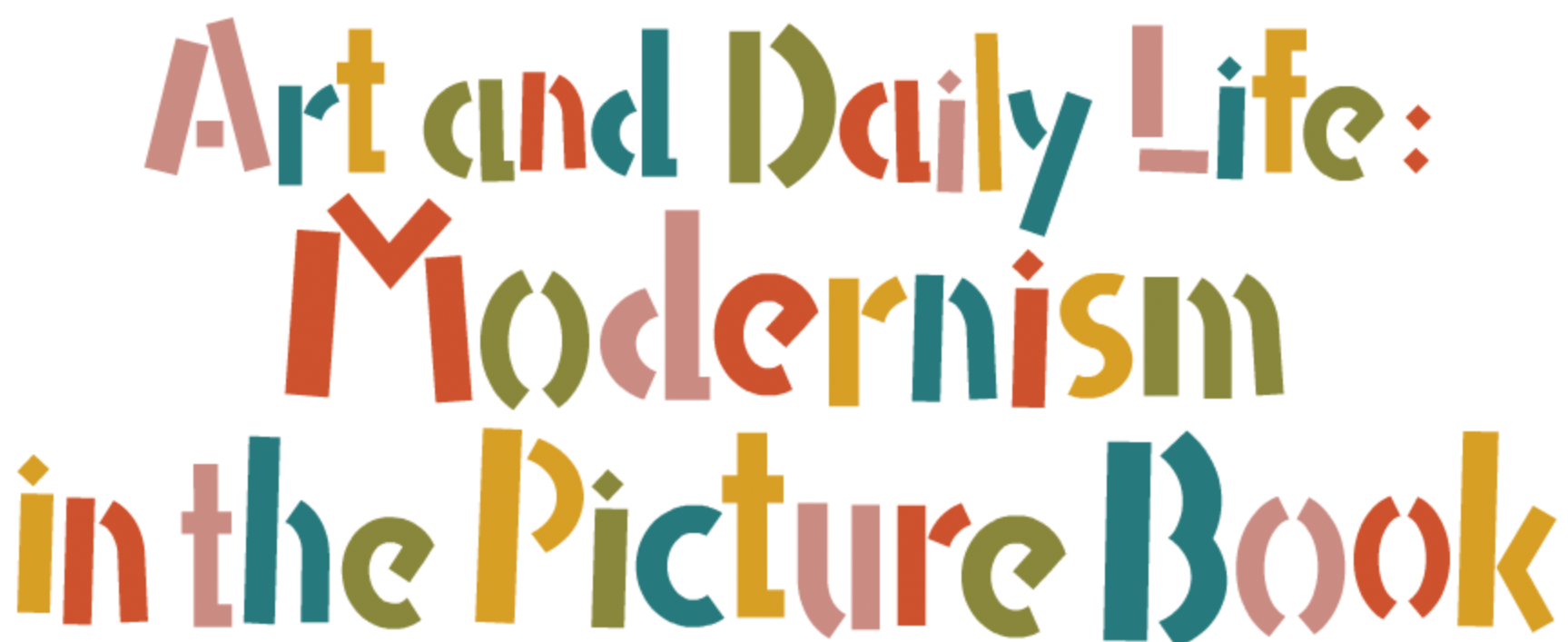本文
Bibliography

The Magic Boat
A Book to Turn, Move and Alter
A Book to Turn, Move and Alter
Das Zauberboot
Herbert Stuffer; Berlin.
1929,
12 pages.
242x207 mm.
1/15
The Magic Boat

2/15 Push an image to enlarge
(♪) The Magic Boat. A Book to Turn, Move and Alter. By Tom Seidmann-Freud
The Wonderful House
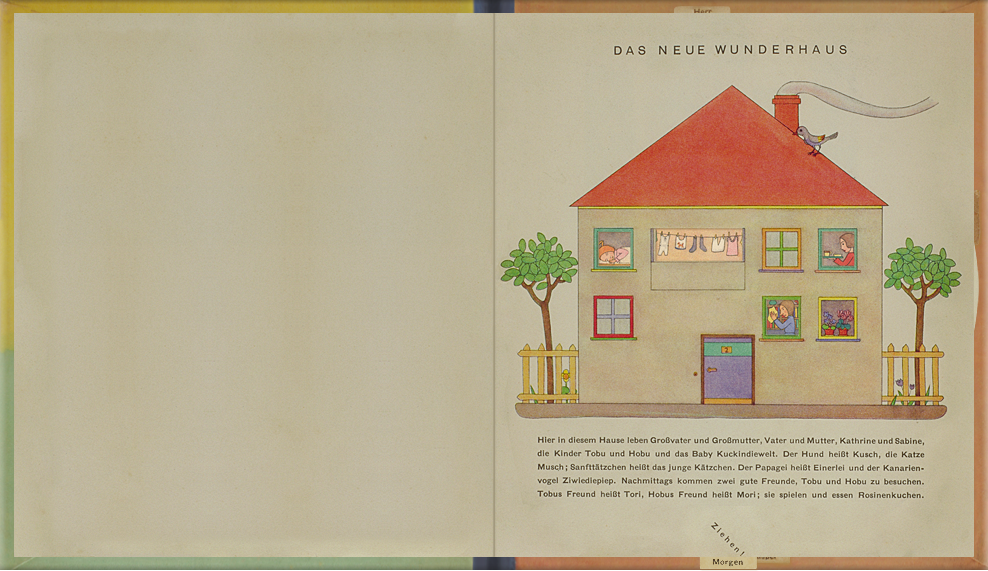
3/15 Push an image to enlarge
(♪) The Wonderful House. (♪) In this house live Grandfather, Grandmother, Father and Mother, Kathrine and Sabine, the little children Tobu and Hobu and the baby Kuckindiewelt. The dog is named Kusch and the cat Musch; while the kitten is named Velvetpaws. The Parrot’s name is Anything and the canary Sweetsweet. In the afternoon, two friends come to visit Hobu and Tobu. Tobu’s friend is called Tori and Hobu’s friend is Mori. They play games together and eat raisin cake.
The Counting Mountain
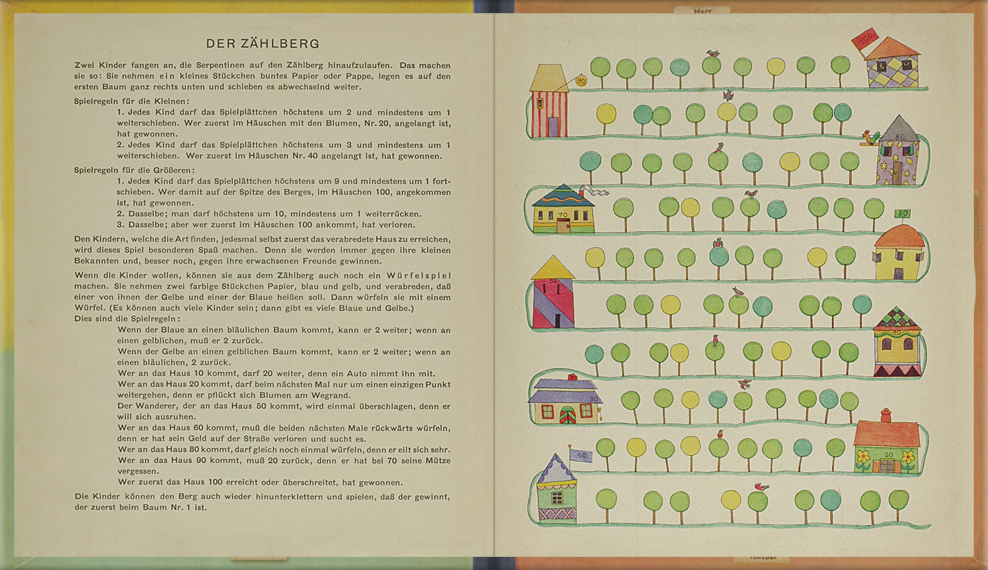
4/15 Push an image to enlarge
(♪) The Counting Mountain. (♪) Two children try to climb the counting mountain, and the game can be played in the following way: Each player takes a piece of cardboard or colored paper and cuts a circle the size of treetops on the board. The players start at the first tree, at the bottom right hand corner and work upwards.(♪)
(Left)The Invisible Child
(Right)Some More Red and Blue Magic Pictures
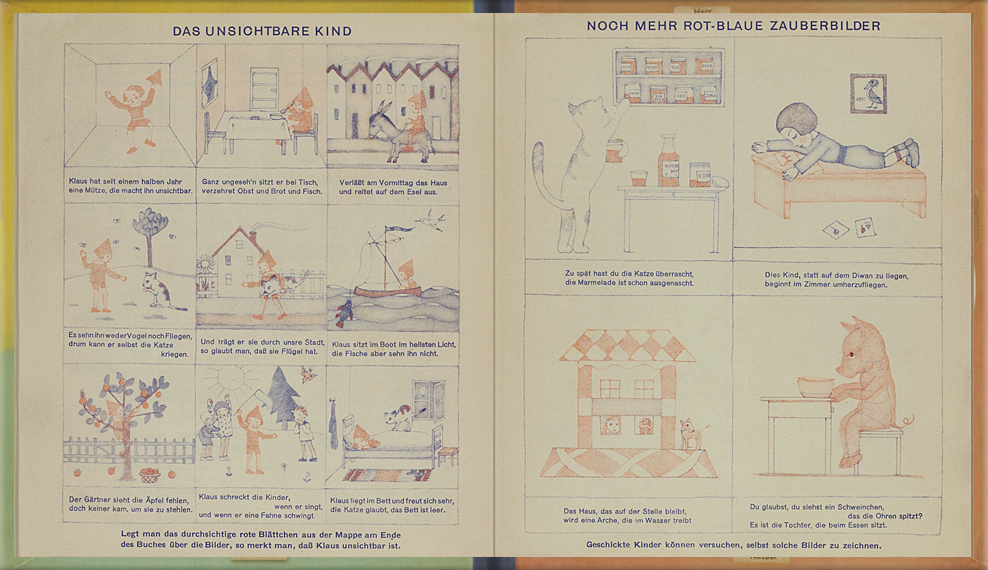
5/15 Push an image to enlarge
The Invisible Child (♪) Klaus has had this cap, which makes him invisible, for six months. (♪) Quite invisible, he sits at the table eating fruit, bread and fish to his heart’s content. (♪) Early in the morning he leaves the house riding on his donkey. (♪) Unseen, he dares to steal the cat. No fly nor bird has noticed that. (♪) As he walks along, carrying the cat, “Look!” shout the crowd, “the cat is flying!” (♪) Klaus goes fishing in the bright light of the day. As he is invisible, fish quickly take his line. (♪) The gardener sees the apples fall. Nobody sees Klaus who makes them fall. (♪) One day, Klaus sings and waves a flag. Children are frightened and run away. (♪) Kitty thinks the bed looks empty even though Klaus is there. Under the covers, Klaus is laughing.
Some More Red and Blue Magic Pictures. “Too late!” the greedy cat is disappointed, the marmalade bottles have been emptied. (♪) This child, who seems to be lying on the sofa, looks as if he is flying in the air. (♪) This house becomes an Ark, sailing on the waters. (♪) You may think it’s a pig with pointed ears, but no, it’s a girl having tea. (♪)
Some More Red and Blue Magic Pictures. “Too late!” the greedy cat is disappointed, the marmalade bottles have been emptied. (♪) This child, who seems to be lying on the sofa, looks as if he is flying in the air. (♪) This house becomes an Ark, sailing on the waters. (♪) You may think it’s a pig with pointed ears, but no, it’s a girl having tea. (♪)
The Race Between the Hare and the Hedgehog
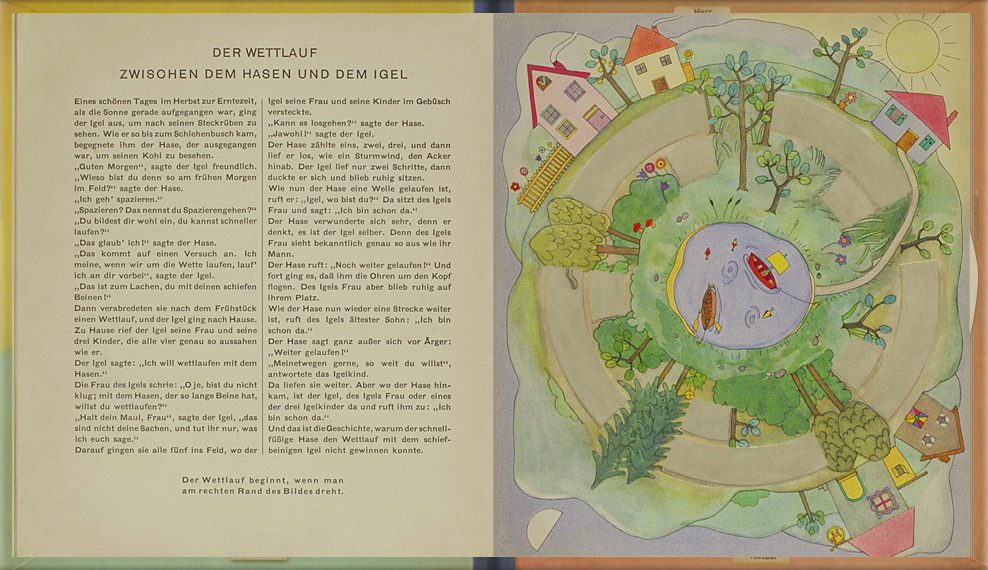
6/15 Push an image to enlarge
The Race Between the Hare and the Hedgehog. (♪) One lovely autumn day, a hedgehog popped out of his hole to look for carrots. Just as he reached the edge of the forest he met the hare, who had come out there to look for carrots. “Good morning!” said the hedgehog. “What are you doing in the field so early in the morning?” asked the hare. “I’m going for a walk.” “Walk? Do you call this walking?” “I suppose you think you can go faster?” “I certainly do,” said the hare. “Then, we should race, but if we do, I will win,” said the hedgehog. “Ha, ha, don’t make me laugh! You race me with your short, crooked legs?!”
(♪) The hedgehog went home and said to his wife and three children, who looked exactly like him, “I am going to have a race with the hare.” “You can’t possibly win,” said his wife. “Never mind, my dear wife,” said the hedgehog. “It’s nothing if only you will do exactly what I tell you.”
(♪) The five of them went off to the field, where the hedgehog hid his wife and children in the hedges. “Are you ready?” said the hare. “Yes,” said the hedgehog.
(♪) The hare counted, one, two, three, and away he dashed like a whirlwind. The hedgehog took one or two steps and then settled down quietly. After the hare had run along for some time he shouted, “Hey, Hedgehog, where are you?” The hedgehog’s wife, who was sitting nearby called out, “Here. Here I am!” The hare was astonished.
(♪) The Hare shouted, “On we go,” and off he went. He had run for a while when the hedgehog’s son called out, “Here I am.” The hare was furious, and said, “We’ll go further.” “Just as you like, as far as ever you wish,” answered the hedgehog’s son. (♪)
(♪) The hedgehog went home and said to his wife and three children, who looked exactly like him, “I am going to have a race with the hare.” “You can’t possibly win,” said his wife. “Never mind, my dear wife,” said the hedgehog. “It’s nothing if only you will do exactly what I tell you.”
(♪) The five of them went off to the field, where the hedgehog hid his wife and children in the hedges. “Are you ready?” said the hare. “Yes,” said the hedgehog.
(♪) The hare counted, one, two, three, and away he dashed like a whirlwind. The hedgehog took one or two steps and then settled down quietly. After the hare had run along for some time he shouted, “Hey, Hedgehog, where are you?” The hedgehog’s wife, who was sitting nearby called out, “Here. Here I am!” The hare was astonished.
(♪) The Hare shouted, “On we go,” and off he went. He had run for a while when the hedgehog’s son called out, “Here I am.” The hare was furious, and said, “We’ll go further.” “Just as you like, as far as ever you wish,” answered the hedgehog’s son. (♪)
(Left)The Chinese Bridge and the Magic Boat
(Right)What do you want to see?
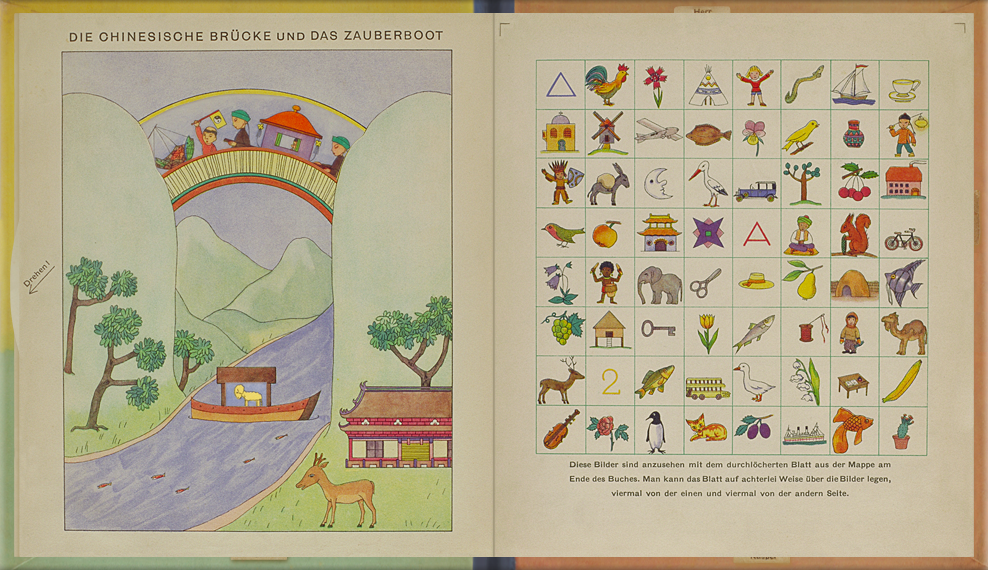
7/15 Push an image to enlarge
The Chinese Bridge and the Magic Boat. (♪)
Pictures of children only! Bird pictures only! Animal pictures only! Fish pictures only!
Pictures of houses only! Flower pictures only! Fruit pictures only! Pictures of vehicles only!
Pictures of children only! Bird pictures only! Animal pictures only! Fish pictures only!
Pictures of houses only! Flower pictures only! Fruit pictures only! Pictures of vehicles only!
The Journey to the East Indies, or Searching for Kasper
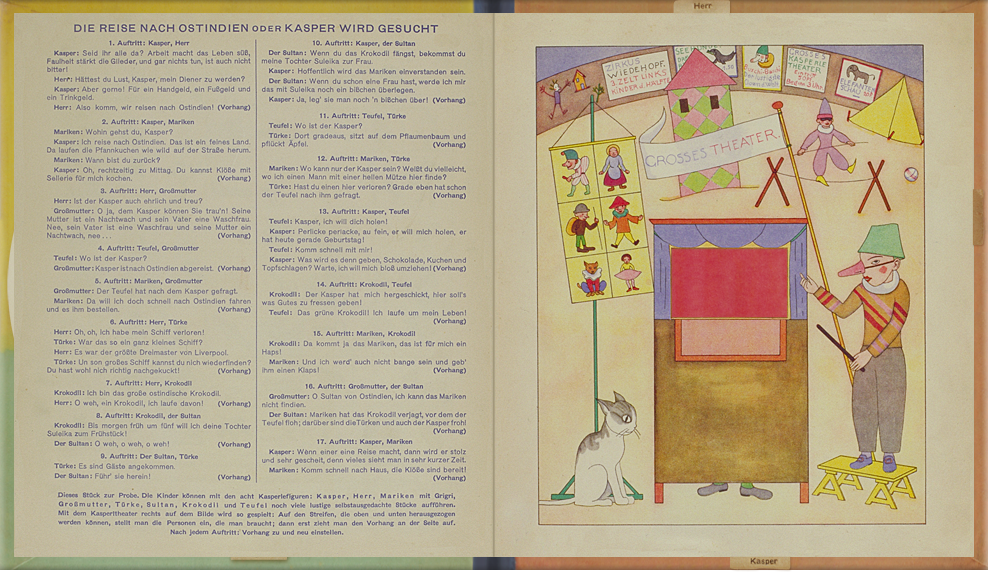
8/15 Push an image to enlarge
The Journey to the East Indies, or Searching for Kasper. (♪) Scene 1: Kasper and Gentleman. Kasper: “Hello! Everybody there? Working makes life pleasant. Lazy people just get fat, but doing nothing is the best of all.” Gentleman: “Would you like to be my servant, Kasper?” Kasper: “Of course, if you give me tips and pocket money.” Gentleman: “Come along then, we’re going on a journey to the East Indies.”
(♪) Scene 2: Kasper and Mariken. Mariken: “Where are you off to, Kasper?” Kasper: “I’m off to the East Indies. That’s a wonderful place, where pancakes grow all over the streets, they say.” Mariken: “When are you coming back?” Kasper: “In time for lunch, and I’ll cook dumplings and celery.”
(♪) Scene 3: Gentleman and Grandmother. Gentleman: “Is Kasper trustworthy and honest?” Grandmother: “Of course, you can trust Kasper. His mother is a night watchman and his father a washerwoman. No, no, his father is a washerwoman and his mother a night watchman. Oh, no, no...”
(♪) Scene 4: The Devil and Grandmother. Devil: “Where is Kasper?” Grandmother: “Kasper has gone on a journey to the East Indies.”
(♪) Scene 5: Mariken and Grandmother. Grandmother: “The Devil has been asking for Kasper.” Mariken: “I must hurry off to the East Indies and tell him.”
(♪) Scene 6: Gentleman and the Turk. Gentleman: “Oh dear, oh dear, I’ve lost my ship.” Turk: “Was it a very tiny ship?” Gentleman: “It was a three-masted sailing ship from Liverpool.” Turk: “You mean you can’t find such a big ship? You couldn’t have looked properly, could you?”
(♪) Scene 7: Gentleman and Crocodile. Crocodile: “I am the big East India Crocodile.” Gentleman: “Mercy me! A crocodile! Help! Let me out of here!”
(♪) Scene 8: The Crocodile and the Sultan. Crocodile: “At five o’clock tomorrow morning I would like to have your daughter Suleika for my breakfast.” Sultan: “Oh, no! What shall we do!”
(♪) Scene 9: The Sultan and the Turk. Turk: “A guest has arrived. Sultan: “Show him in.”
(♪) Scene 10: Kasper and the Sultan. Sultan: “If you will catch the crocodile you shall have my daughter Suleika as your wife.” Kasper: “I wonder if Mariken will agree.” Sultan: “If you already have a wife I had better think the matter over.” Kasper: “Yes, it’s better to think it over.”
(♪) Scene 11: The Devil and the Turk. Devil: “Where’s Kasper?” Turk: “There! He is sitting in the plum tree picking the apples.”
(♪) Scene 12: Mariken and the Turk. Mariken: “Where on earth is Kasper? Do you know where I can find a man with a colored cap?” Turk: “Have you lost him? The Devil was asking about him just now.”
(♪) Scene 13: Kasper and the Devil. Devil: “I’ve come to fetch you.” Kasper: “What! Who! You have come to fetch me? It’s my birthday today, so you won’t catch me!” Devil: “Come quickly.” Kasper: “What are we going to have? Chocolate, cake, a lollypop? Just a minute, I’ll go and change.”
(♪) Scene 14: The Crocodile and the Devil.” Crocodile: “Kasper sent me here. He said I could find something good to eat.” Devil: “The green crocodile! I must escape. He will kill me.”
(♪) Scene 15: Mariken and the Crocodile. Crocodile: “Here comes Mariken. I’m in luck! Mariken: “I’m not afraid of you. What shall I give you?”
(♪) Scene 16: Grandmother and Sultan. Grandmother: “Oh, Sultan of India, I can’t find Mariken.” Sultan: “Brave Mariken chased away the crocodile from whom even the Devil fled. That’s why Turk and Kasper were saved. It was such a noble deed.”
(♪) Scene 17: Kasper and Mariken. Kasper: “Who ever goes on a journey should be very proud and clever, for in a short time he learns more than ever.” Mariken: “Come, hurry home, the dumplings are ready.” (♪)
(♪) Scene 2: Kasper and Mariken. Mariken: “Where are you off to, Kasper?” Kasper: “I’m off to the East Indies. That’s a wonderful place, where pancakes grow all over the streets, they say.” Mariken: “When are you coming back?” Kasper: “In time for lunch, and I’ll cook dumplings and celery.”
(♪) Scene 3: Gentleman and Grandmother. Gentleman: “Is Kasper trustworthy and honest?” Grandmother: “Of course, you can trust Kasper. His mother is a night watchman and his father a washerwoman. No, no, his father is a washerwoman and his mother a night watchman. Oh, no, no...”
(♪) Scene 4: The Devil and Grandmother. Devil: “Where is Kasper?” Grandmother: “Kasper has gone on a journey to the East Indies.”
(♪) Scene 5: Mariken and Grandmother. Grandmother: “The Devil has been asking for Kasper.” Mariken: “I must hurry off to the East Indies and tell him.”
(♪) Scene 6: Gentleman and the Turk. Gentleman: “Oh dear, oh dear, I’ve lost my ship.” Turk: “Was it a very tiny ship?” Gentleman: “It was a three-masted sailing ship from Liverpool.” Turk: “You mean you can’t find such a big ship? You couldn’t have looked properly, could you?”
(♪) Scene 7: Gentleman and Crocodile. Crocodile: “I am the big East India Crocodile.” Gentleman: “Mercy me! A crocodile! Help! Let me out of here!”
(♪) Scene 8: The Crocodile and the Sultan. Crocodile: “At five o’clock tomorrow morning I would like to have your daughter Suleika for my breakfast.” Sultan: “Oh, no! What shall we do!”
(♪) Scene 9: The Sultan and the Turk. Turk: “A guest has arrived. Sultan: “Show him in.”
(♪) Scene 10: Kasper and the Sultan. Sultan: “If you will catch the crocodile you shall have my daughter Suleika as your wife.” Kasper: “I wonder if Mariken will agree.” Sultan: “If you already have a wife I had better think the matter over.” Kasper: “Yes, it’s better to think it over.”
(♪) Scene 11: The Devil and the Turk. Devil: “Where’s Kasper?” Turk: “There! He is sitting in the plum tree picking the apples.”
(♪) Scene 12: Mariken and the Turk. Mariken: “Where on earth is Kasper? Do you know where I can find a man with a colored cap?” Turk: “Have you lost him? The Devil was asking about him just now.”
(♪) Scene 13: Kasper and the Devil. Devil: “I’ve come to fetch you.” Kasper: “What! Who! You have come to fetch me? It’s my birthday today, so you won’t catch me!” Devil: “Come quickly.” Kasper: “What are we going to have? Chocolate, cake, a lollypop? Just a minute, I’ll go and change.”
(♪) Scene 14: The Crocodile and the Devil.” Crocodile: “Kasper sent me here. He said I could find something good to eat.” Devil: “The green crocodile! I must escape. He will kill me.”
(♪) Scene 15: Mariken and the Crocodile. Crocodile: “Here comes Mariken. I’m in luck! Mariken: “I’m not afraid of you. What shall I give you?”
(♪) Scene 16: Grandmother and Sultan. Grandmother: “Oh, Sultan of India, I can’t find Mariken.” Sultan: “Brave Mariken chased away the crocodile from whom even the Devil fled. That’s why Turk and Kasper were saved. It was such a noble deed.”
(♪) Scene 17: Kasper and Mariken. Kasper: “Who ever goes on a journey should be very proud and clever, for in a short time he learns more than ever.” Mariken: “Come, hurry home, the dumplings are ready.” (♪)
No narration on page 9
The Magic Boat
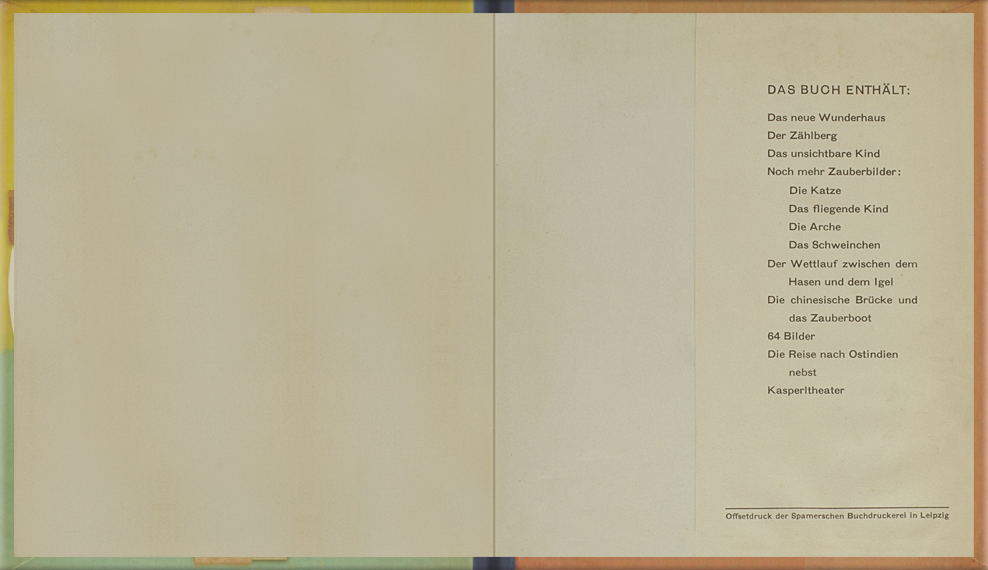
9/15 Push an image to enlarge
No narration on page 10
The Magic Boat

10/15 Push an image to enlarge
No narration on page 11
About the author 1/4
By Tom Seidmann-Freud (1892-1930)\
1)
“Tom” (Martha) Seidmann-Freud was born in 1892 in Vienna, a niece of the father of psychoanalysis Sigmund Freud. Prolific in writing and drawing since her youth and good at empathizing with children, she published many picture books from 1918 onward. As a member of a Jewish congregation, her works were also published in Hebrew. She died in Berlin in 1930 and her work was suppressed by the National Socialists in 1937.Reviews of Seidmann-Freud’s works describe them as totally free from adult imagination but close to children’s own experience both in text and illustration, yet without stooping to the level of the child. Limited in lyrical expression, they appear to be aimed at educating children of preschool or the early grades of elementary school.
11/15
No narration on page 12
About the author 2/4
2)
Her works include those that, like The Magic Boat, are retellings of traditional stories with contrivances for turning or moving things in the story. While influenced by 1920-1930 styles of art, in “The Book of Rabbit Stories” (Buch der Hasengeschichten) she uses a very simple style that is one-dimensional and understandable, avoiding overlapping of images and a complicated use of space by isolating not only the objects but also the situations. She even draws the scenes of a conversation with the objects shown symmetrically from the side. Viewing children as independent readers and serious observers, her picture books are playfully, but unswervingly designed for educational purposes.
12/15
No narration on page 13
About the author 3/4
3)
In a 1930 critique, Walter Benjamin called Seidmann-Freud’s play reader “Bravo, We Read! Bravo, We Write! (Hurra, wir lessen! Hurra, wir schreiben!)” one of the most progressive works in the genre. He praised the idea of combining words and pictures in a reader-cum-notebook as being part of a long tradition.
13/15
No narration on page 14
About the author 4/4
4)
Tom Seidmann-Freud’s goal was to provide practice unconsciously in the course of play. In the preface of the book she explains that the most important principle in the educational purpose of the book is not the learning or achievement of some assignment given by grownups. When we consider the inherent nature of a child, learning is adventure. The old style of schooling compels children to constantly progress towards the object, competing with each other to master the subjects demanded by the almighty adult, thus closing forever the door through which children come to truly understand.It is a great pleasure to introduce here The Magic Boat, a work that Bettina Hurlimann introduced in her Three Centuries of Children’s Book in Europe (1959) , declaring her intention to rescue the book from the abyss of oblivion into which it had been dropped by the cruel times in which it was written.
14/15
Contents
15/15
